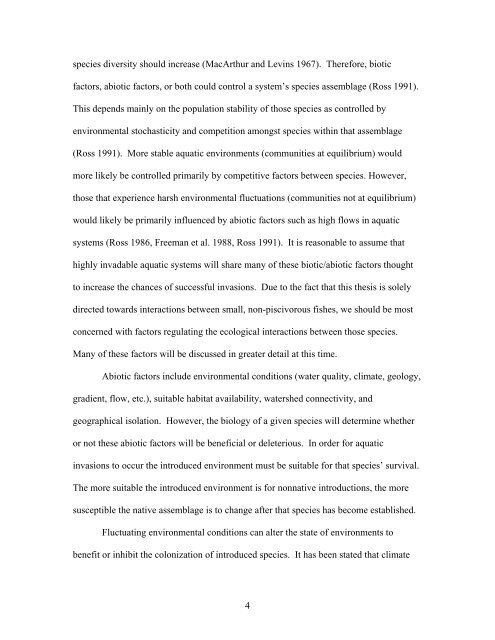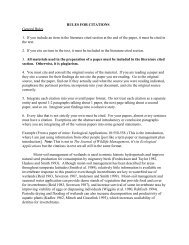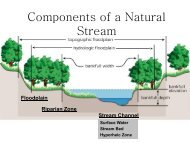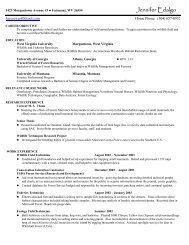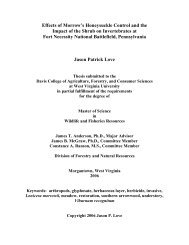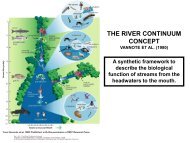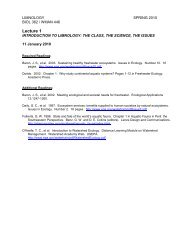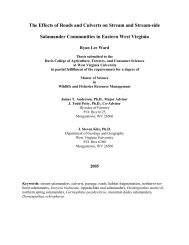An Experimental Study of Vertical Habitat Use and Habitat Shifts in ...
An Experimental Study of Vertical Habitat Use and Habitat Shifts in ...
An Experimental Study of Vertical Habitat Use and Habitat Shifts in ...
You also want an ePaper? Increase the reach of your titles
YUMPU automatically turns print PDFs into web optimized ePapers that Google loves.
species diversity should <strong>in</strong>crease (MacArthur <strong>and</strong> Lev<strong>in</strong>s 1967). Therefore, biotic<br />
factors, abiotic factors, or both could control a system’s species assemblage (Ross 1991).<br />
This depends ma<strong>in</strong>ly on the population stability <strong>of</strong> those species as controlled by<br />
environmental stochasticity <strong>and</strong> competition amongst species with<strong>in</strong> that assemblage<br />
(Ross 1991). More stable aquatic environments (communities at equilibrium) would<br />
more likely be controlled primarily by competitive factors between species. However,<br />
those that experience harsh environmental fluctuations (communities not at equilibrium)<br />
would likely be primarily <strong>in</strong>fluenced by abiotic factors such as high flows <strong>in</strong> aquatic<br />
systems (Ross 1986, Freeman et al. 1988, Ross 1991). It is reasonable to assume that<br />
highly <strong>in</strong>vadable aquatic systems will share many <strong>of</strong> these biotic/abiotic factors thought<br />
to <strong>in</strong>crease the chances <strong>of</strong> successful <strong>in</strong>vasions. Due to the fact that this thesis is solely<br />
directed towards <strong>in</strong>teractions between small, non-piscivorous fishes, we should be most<br />
concerned with factors regulat<strong>in</strong>g the ecological <strong>in</strong>teractions between those species.<br />
Many <strong>of</strong> these factors will be discussed <strong>in</strong> greater detail at this time.<br />
Abiotic factors <strong>in</strong>clude environmental conditions (water quality, climate, geology,<br />
gradient, flow, etc.), suitable habitat availability, watershed connectivity, <strong>and</strong><br />
geographical isolation. However, the biology <strong>of</strong> a given species will determ<strong>in</strong>e whether<br />
or not these abiotic factors will be beneficial or deleterious. In order for aquatic<br />
<strong>in</strong>vasions to occur the <strong>in</strong>troduced environment must be suitable for that species’ survival.<br />
The more suitable the <strong>in</strong>troduced environment is for nonnative <strong>in</strong>troductions, the more<br />
susceptible the native assemblage is to change after that species has become established.<br />
Fluctuat<strong>in</strong>g environmental conditions can alter the state <strong>of</strong> environments to<br />
benefit or <strong>in</strong>hibit the colonization <strong>of</strong> <strong>in</strong>troduced species. It has been stated that climate<br />
4


